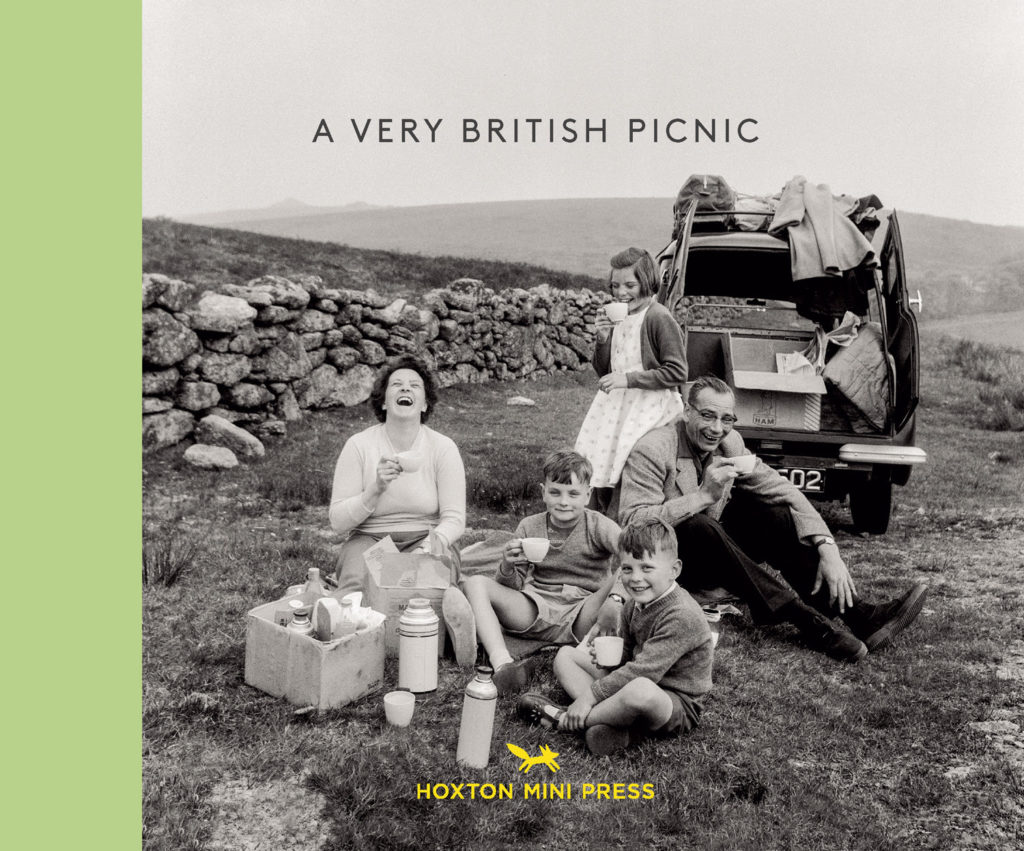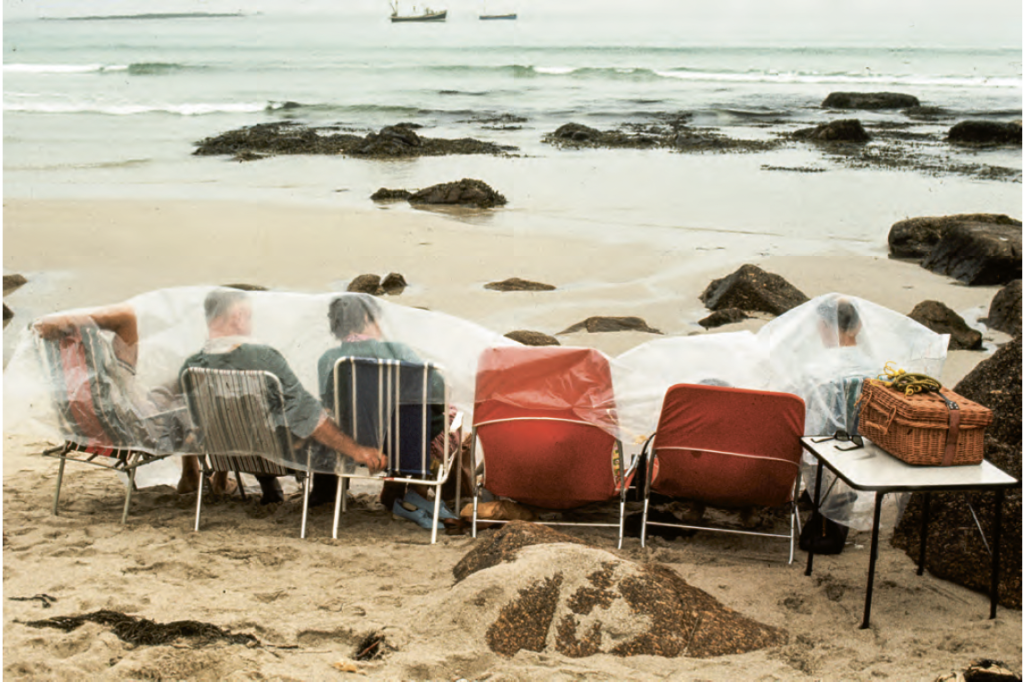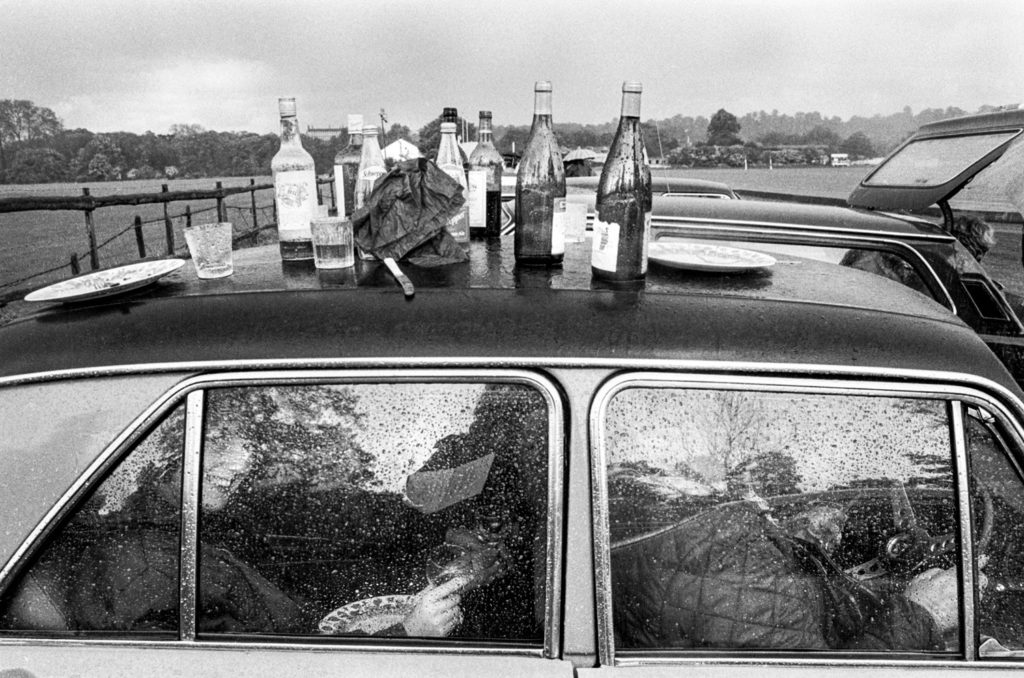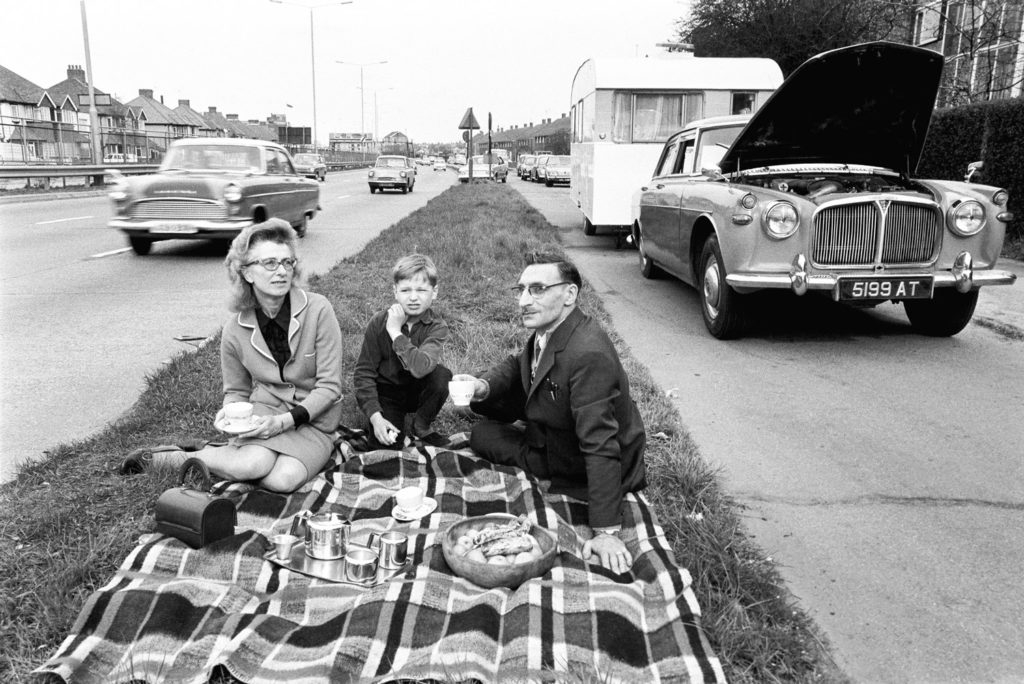Latest Hoxton Mini Press title ‘A Very British Picnic’ delightfully captures the obstinacy of the picnicking ritual across eight decades, writes Alistair Fitchett.

With the summer months stretching luxuriously ahead of us (in the Northern hemisphere at least) I’m sure that many of our thoughts turn to picnics in the sun. Certainly the folks at Hoxton Mini Press think so, as they anticipate the season with a new entry in their always enjoyable ‘Vintage Britain’ series. A Very British Picnic is the eleventh instalment in a series so far dominated by London-centric titles (fair enough for a small press founded on the notion of celebrating personal locality and history), spreading its blanket on the ground to cover the fields, lakes, seasides, mountains and motorway verges of our sometimes green and occasionally pleasant land.
Defining the boundaries of ‘vintage’ can be a tricky business, but here the net is cast firmly within the twentieth century, with the earliest photograph from New Year’s Day 1900 and the latest from the splendid summer of 1983. In the former photograph rows of be-hatted Ladies and Gentlemen sit formally at wooden picnic tables whilst in the latter (one of the few colour images) two ladies sit amongst hay bales and prize cattle at a country show in Cheshire. Summer dresses, plastic bags and a cardboard box containing flasks of tea perfectly capture that particularly glorious summer in gorgeously warm hues. These two photographs might be more than eight decades (and two seasons) apart, yet both somehow capture the essential obstinacy of the British picnic. That sense of ‘we’re doing this because we said we’d do it, and nothing is going to stop us’ pervades many of the photographs in the book and is one of the qualities that lends the images an irresistible evocative energy. This obstinacy is fired at least in part by the ritualistic element of the British picnic, one that is rooted squarely in the metronomic daily punctuation of Taking Tea. Viewed from the 21st Century this can seem simultaneously quaint, inexplicable and strangely appealing; a yearning, if you will, for a sense of dependable structure imposed on an otherwise bewilderingly fractured life.
Another thread of imposed structure underpinning the photographs of course is that of Class. Here are Cecil Beaton and his coterie of beautiful young people taking tea (and champagne, naturally) in the bucolic surroundings of a Country House, whilst there lies a member of the Bedlington Miner’s Club, sated from his poke of chips and five cans of Harp lager. Elsewhere we find some of the newly minted Middle Classes of the early 1950s pausing from their caravan tour in a sun-dappled glade, an image that contrasts nicely with a contemporaneous shot of a Working Class family (you can tell by the knotted hankie on dad’s head) feasting on Tizer and jammy pieces. All of these images remind us too that there is something exclusive, or at least excluding about the picnic group. Boundaries are clearly defined, not least by the postage stamp of blanket on which the accoutrements of the picnic may be elegantly arranged like a Cezanne still life, but also by the characters invited to the party, willingly or otherwise. The picnic, and the making of photographs, therefore, acts as both a democratising agent and a vehicle for reinforcing social divisions.

Regardless of Class, however, throughout these photographs the best times seem almost exclusively to belong to groups of friends rather than families: Liverpool F.C. fans outside Wembley Stadium in 1977; Young People in bathing suits partially submerged in the sea at Jersey in 1929, delighting in tea being poured into porcelain cups on a floating tea tray; their circa 1935 versions enjoying the hippest sounds emanating from a portable gramophone player in the dunes; Brownies in Richmond Park, 1937, the rain barely noticed in the face of the young deer that sniff their proffered sandwiches; the Bathing Suit Beauties Of Eastbourne Beach (imagined headline courtesy Tabloid Journalism 101) enjoying a bottle of lemonade or possibly something stronger, the distant lighthouse thrusting upwards as a hilarious symbol of rejected manhood (it’s not that small, it’s just further away…) and (my particular favourites) the women spreading themselves languorously on the rocks overlooking Cheddar Gorge in the mid 1930s. Even the numerable shots of toffs at Glyndebourne down the decades display a degree of elegantly muted mutual appreciation for their immediate context. In contrast, the photographs of families are full of downcast eyes, awkward poses, distinctly uncomfortable sons and daughters wishing they could be anywhere else. In many of these shots not even mum and dad seem convinced that there is much real enjoyment to be had, yet they (just about) grin and bear it regardless. That obstinacy again.
Naturally I admit I am projecting on this, as is our inevitable want when reading texts. I remember that my own family picnics, such as they were, seemed very much ad-hoc affairs. I’m not sure they were ever even referred to as picnics but rather as little more than tea breaks. Punctuation points on the journey, barely worth bothering about and certainly not worth celebrating as events in themselves. Sandwiches wrapped in tinfoil and tea from the tartan flask consumed swiftly before moving on again. Chances were we would not even make it out of car except for nipping behind some undergrowth for a wee. The closest anything in this book gets to my personal memories therefore is a 1959 shot of Carding Hill Valley in Shropshire where multiple cars are parked up and their inhabitants spill onto clumps of grass, barely a folding chair or wicker basket in sight.

Somewhere in an album at the bottom of my parents’ wardrobe sit photographs of my dad behind the wheel of various second or third hand cars enjoying one of his hand-rolled cigarettes and a steaming cup of tea. I have no idea where we might have been heading to, or home from, but they are nevertheless poignant mementoes despite, or possibly because of, their implied rejection of the traditional picnic rituals. Tucked away in one of those albums, however, also exists a photograph where I am standing on the periphery of a friend’s family group, perhaps looking longingly at the organised perfection of their setup: Blanket on the ground; willow basket with enamel plates and mugs; folding chairs for the parents. Inevitably, time showed this was all a façade. The apparent, projected order was built on chaos. Unseen whirlpools of tension would ultimately tear things apart. Our disorder on the other hand was, if not directly visible, at least not so carefully obscured. In hindsight I am rather glad of this.
Being Scottish (with a mix of Yorkshire — surely the ultimate source of obstinacy) it occurs to me that my family’s absence of organisation and ritual with regards to The Picnic suggests that the event, as idealised in collective vision at least, is therefore An English Thing. Indeed, a closer perusal of the locations pictured in the books does seem to bear this out, to the point that perhaps a more accurate title would be A Very British (but almost exclusively English) Picnic. There is just one photograph in Scotland (four walkers in 1937, stripped to underwear or more likely bathing costumes, taking tea on the snowy slopes of Ben Lawers in the Highlands) and one in Wales (a Classic Family Group of four photographed two years earlier at Little Orme, Llandudno). Both these photographs are worth closer examination for reasons other than their geographical anomalies, however, as they contain the essence of the photographer as the unseen protagonist and neatly illustrate the question of purpose and meaning in photography. It is of course possible that both pictures were made with tripods and timers, but the careful composition and staging suggests against it. Instead, there is a feeling that these, and many of the other photographs collected in the book, were made for advertising or editorial purposes, a suspicion borne out by a perusal of the credits. A few ‘name’ photographers stand out (notably, to my eye at least, Erich Auerbach and Tony Ray Jones) but the vast majority have come from picture libraries, advertising archives and the like. Indeed, I admit it makes me rather envious to think of the book’s curators searching such archives, seeking connecting threads to be pulled together from their thrilling finds.

It’s certainly clear that those curators must have had a great deal of fun in compiling the book, for there are any number of carefully considered juxtapositions which raise a smile. In one spread we find a couple of young children taking tea in 1947 in front of a miniature Wendy House, hemmed in by a white picket fence. Facing them across the page are a couple of bow-tied chaps supping wine some thirty years later with the impressive country house architecture of Glyndebourne floating in the background. They sit on the edge of a lawn, their feet dangling over the brick-faced retaining wall of the terrace, the pattern reflecting deliciously the faux-brickwork of the Wendy house on the opposite page. Overleaf, the precariously balanced Brimham Rocks photographed by Tony Ray Jones in 1968 find a lighthearted equivalence in the strange portable tiered plate contraption snapped at the 1933 National Exhibition of Camping. The lady demonstrating the device’s appeal does not seem entirely convinced, which is fair enough. Speaking of Jones, it is perhaps a shame that we don’t see his own iconic shot of a couple picnicking at Glyndebourne. Made a decade before the aforementioned shot of the chaps dangling their legs over the ha-ha, Jones’ photograph looked in the opposite direction, using the unseen drop in level to create the optical illusion of cows about to encroach on the lawn. It is such a playfully self-knowing photograph and would have fitted perfectly here.
Elsewhere in the book little batches of photographs are arranged with more obvious connecting themes. Here a sprinkling connected by the notion of dressing up (humans, a dog, some teddy bears), there a short sequence of picnics beside tents. The tent photographs are particularly delightful, with a spread showing some hippies at the 1970 Isle of Wight festival juxtaposed with a 1920 shot of three wee boys in Regent’s park, their makeshift tent of threadbare tattered rugs no doubt representing a magnificent teepee in a game of cowboys and Indians. Later in the book another tent makes an appearance, this time next to a 1930s aircraft, in which the protagonists have evidently flown to their chosen picnic spot. Two ladies in shorts fix tea, one of them handing the man the box of sandwiches. Well, he has been good enough to pilot the airplane, after all.
I could go on, for there are so many delicious photographs collected here that suggest innumerable tangential stories within the broader narrative of a historical social overview of Britain (okay, again, mostly England) during the twentieth century. For anyone who delights in the visual language of photography, then, A Very British Picnic provides a tremendous time-machine in which to dart around the changing and timeless landscapes through which we might travel. An addictive and hugely enjoyable collection.
*
‘A Very British Picnic’ is out now and available here (£17.95).